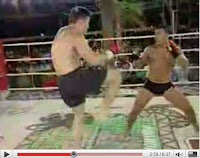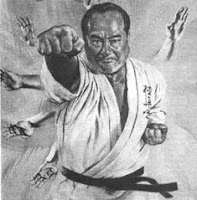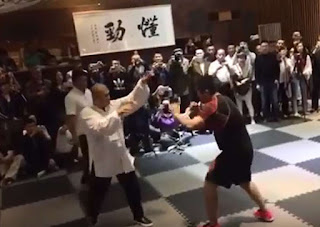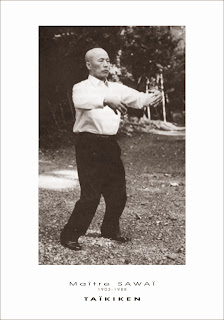Visible force vs. applied force
 A correspondent recently wrote to me asking about our martial art. He made the comment that “It seems great but a bit lacking in power.”
A correspondent recently wrote to me asking about our martial art. He made the comment that “It seems great but a bit lacking in power.”I told him that if by that he meant visible force — yes, he was right. However “visible force” and “applied force” are 2 different things. Some techniques don't look "powerful" because they have a lot less "push". [For a detailed explanation of "force", "power" and the role these play in "hitting hard" rather than "pushing" see my article "Hitting harder: physics made easy".]
The front kick is a case in point. If you do it against a heavy bag you'll be tempted to hit it with more push so as to "feel powerful". On the other hand, when you kick a kickshield you can give it a resounding "crack" that your partner feels right through the shield but which doesn't move him or her more than a foot or 2. As a rule, we don't let students kick or punch the heavy bag until they have mastered the kickshield and makiwara (phone books work well) so as to develop the correct type of focus for bare-knuckle fighting. Compare the “pushing” kick to the “shock” kick in the following video:
It is a simple matter of physics that the more "push" there is to a technique (ie. the more you displace your opponent), the less you've injured him or her. Compare a hard shove that throws your opponent across the room with a sharp snapping kick to the groin and you'll see what I mean. See the following video which illustrates the targets for kicks in traditional karate using these “shock kicks” and consider whether you would be happy to take those blows...
 The frames to the right illustrate the effect of the “shock kick” — note the “shaking” of the opponent, but the minimal displacement.
The frames to the right illustrate the effect of the “shock kick” — note the “shaking” of the opponent, but the minimal displacement. Most karateka have, in my view, rejected the old snapping kicks and punches of old karate which produce what is called a "hydrostatic shock" (you're 80% water). Instead they have gone for methods that are more akin to boxing. The latter is easier to understand, looks visually more impressive, and is easier to learn, so it's no surprise.
 As an example, consider the frames to the left which illustrate the effect of the “push” kick on your opponent. Note the large displacement of your opponent, which is the kicker’s energy being converted to kinetic energy rather than a more destructive energy.
As an example, consider the frames to the left which illustrate the effect of the “push” kick on your opponent. Note the large displacement of your opponent, which is the kicker’s energy being converted to kinetic energy rather than a more destructive energy. Boxers tend to use a more "pushing blow" mostly because of the padded glove. This makes it necessary to impart more "kinetic energy" in order to achieve the same destructive energy transfer. It's like comparing a hit from a heavy pillow to the flick from a wet towel.
From what I see of kicks in kickboxing, Muay Thai and MMA, they suffer from too much heavy bag training at the expense of shield training. The heavy bag is nothing like the human body. It has its uses (important ones), but not to develop the type of "focus" (kime) I'm talking about.
 I haven't seen many people do a decent front kick in MMA — Lyoto Machida is one of the few. It's a hard technique to learn but very effective and totally under-used (see the picture to the left of Machida doing a front kick to Rich "Ace" Franklin).
I haven't seen many people do a decent front kick in MMA — Lyoto Machida is one of the few. It's a hard technique to learn but very effective and totally under-used (see the picture to the left of Machida doing a front kick to Rich "Ace" Franklin). On the fightingarts.com forum Victor Smith recently noted:
"I was recently reading several interviews with senior Okinawan Shorin-ryu instructors, Iha Seikichi and Miyahira Katsuya, and in the course of those discussions they both made the same point about kicking.
http://www.okinawankarateandkobudoinstitute.com/Seikichi%20Iha%20Sensei.htm
“In the “old days,” the kick was never extended past the extended punch. You always kicked within the extended fist. It is too difficult to do nowadays and students just ignore this concept. Nowadays, the students often seek the easier way and extend their kicks way past their fist. This is the sport kick, but it is okay for those who do not really understand kicking.”
“Remember that in kicking, the foot itself must be tight with the leg loose. You then hinge the kick out. The kick must be chambered, then kick and then re-chambered before the foot is set down…
Miyahira Katsuya stated, “The Shorin-ryu stydent must work on retracting their kicks quickly. They must also practice kicking within an arm’s reach. This is highly important in doing good Shorin-ryu kicks. The kick does not extend out but within the length of one’s arm.”
IMO, this fully describes how Shimabuku Sensei was kicking in our video reference of his technique.
Kicking at the range of direct engagement, striking distance. Fully raising the leg and then kicking out and retracting the kick, at a very close distance."
[To see the full thread, go to the fightingarts.com forum: here.]
Copyright © 2008 Dejan Djurdjevic



Dan,
ReplyDeleteI love your articles about force, impulse, push, and focus. However, I have two questions.
1) I know that the show "Fight Science" has quite a few scientific flaws, especially in the earlier episodes, but what do you think about the tests done at the beginning of the "Stealth Warriors" episode. I believe you should be able to access it on Hulu.com
2) You mention phonebooks being suitable replacements for makiwara training. Do you mean that they can be used with one person holding them at the top, while a second person hits the bottom, so it sways, like in one of your videos? And if so, do you have any ideas on how you could do solo practice with phonebooks?
As always, I wish your articles were more visible to all martial artists (and quite a few scientists).
Thanks.
First, thank you very much Mohammad for your encouragement and support. It is greatly appreciated.
ReplyDeleteI can't access Hulu.com here in Australia, but I did watch what I think were the opening segments of that show (where they had 2 guys jumping off things and between things. It looked quite good, from what I could tell.
As to the phonebooks, there are different methods you can use.
One is to hold the top, while someone punches the middle and the bottom remains loose.
My preferred method is for your partner to hold the phonebook with the spine vertical, the bottom touching your lower stomach and the top about 1-2 fists away from your upper stomach. When you punch, the book should collapse into the gap between the book and your partner's stomach. It goes without saying that your partner should tense his/her stomach muscles. Avoid striking in line with the solar plexus. Your partner should preferably stand in sanchin stance.
Good luck!
I forgot to say: for single person practice, try to rig up an L frame sticking out from a wall. Drill 2 holes in the spine end - about an inch down and fix the book to the bottom of the L frame with U hooks.
ReplyDeleteHope this helps!
http://ymarsakar.wordpress.com/2011/06/20/reply-to-applied-force-vs-visible-force-in-tmamma/
ReplyDeleteWrote up a reply here. I also liked your internal martial arts vs external martial arts, which I read after writing that.
Hi Dan,
ReplyDeleteRon Goninan here. Really enjoying your articles. If you want some more discussion try out the OzBudo Forum (http://www.ozbudo.com/forum/index.php). It's a good place, no politics, no ego's, just good discussion.
Best wishes!